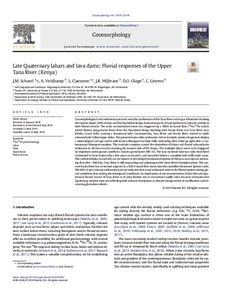| dc.contributor.author | Schoorl, J.M. |
| dc.contributor.author | Veldkamp, A. |
| dc.contributor.author | Claessens, L. |
| dc.contributor.author | Wijbrans, J.R. |
| dc.contributor.author | Olago, D.O. |
| dc.contributor.author | Lievens, C. |
| dc.date.accessioned | 2019-12-04T11:33:56Z |
| dc.date.available | 2019-12-04T11:33:56Z |
| dc.date.issued | 2019-09-15 |
| dc.identifier.citation | Schoorl, J.M., Veldkamp, A., Claessens, L., Wijbrans, J.R., Olago, D.O. & Lievens, C. (2019). Late quaternary lahars and lava dams: fluvial responses of the upper Tana river (Kenya). Geomorphology, 341, 28-45. |
| dc.identifier.issn | 0169-555X |
| dc.identifier.uri | https://hdl.handle.net/20.500.12478/5850 |
| dc.description.abstract | Geomorphological and sedimentary records near the confluences of the Tana River and major tributaries draining the eastern slopes of Mt. Kenya and the Nyambeni Range, indicate impacts of Late Quaternary volcanic activity in their fluvial records. The main reconstructed event was triggered by a 366.9 ka basalt flow (40Ar/39Ar dated) which flowed along Kazita River from the Nyambeni Range blocking both Kazita River and Tana River near Kibuka Grand Falls, causing a temporary lake. Consequently, Tana River and Kazita River started to build volcanoclastic Gilbert type deltas. The preserved pro-delta sediments rich in trachytic pumice fragments display a mineralogical and age match with known Ithanguni trachytic tuffs, indicating delta build up right after a contemporary Ithanguni eruption. This trachytic eruption caused the deposition of lahars and fluvial volcaniclastic sediments in all river records draining the Eastern side of Mt. Kenya. The multiple lahars seem to be triggered by eruptions under glacial conditions (basalt age indicates MIS 10). The lava dammed lake was only short lived (estimated to have lasted only a few years to decades) and breached before a complete lake infill could occur. The current Kibuka Grand Falls can be viewed as the delayed incisional response of this lava dam breach, indicating that after >366.9 ka, Tana River is still responding and adjusting to this short-lived disruptive phase. The current Kazita River has re-incised adjacent to a MIS 4 basalt flow down into the crystalline Basement System rocks. The MIS 10 pre-volcanic sedimentary record indicates that more sediments were in the fluvial system during glacial conditions than during the interglacial conditions. An implication of our reconstruction is that the Late Quaternary fluvial record of Tana River is of only limited use to reconstruct uplift rates because reconstructed Quaternary incision rates are reflecting both volcanic disruptions as climate change trends of aridification and decreasing glaciation extents. |
| dc.format.extent | 28-45 |
| dc.language.iso | en |
| dc.rights | Copyrighted; all rights reserved |
| dc.subject | Climate Change |
| dc.subject | Data |
| dc.subject | Reduction |
| dc.subject | Kenya |
| dc.subject | Geomorphology |
| dc.subject | Rivers |
| dc.title | Late quaternary lahars and lava dams: fluvial responses of the upper Tana river (Kenya) |
| dc.type | Journal Article |
| dc.description.version | Peer Review |
| cg.contributor.crp | Maize |
| cg.contributor.affiliation | Wageningen University and Research Centre |
| cg.contributor.affiliation | University of Twente |
| cg.contributor.affiliation | International Institute of Tropical Agriculture |
| cg.contributor.affiliation | Vrije Universiteit Amsterdam |
| cg.contributor.affiliation | University of Nairobi |
| cg.coverage.region | Africa |
| cg.coverage.region | East Africa |
| cg.coverage.country | Kenya |
| cg.creator.identifier | Lieven Claessens: 0000-0003-2961-8990 |
| cg.researchtheme | NATURAL RESOURCE MANAGEMENT |
| cg.isijournal | ISI Journal |
| cg.authorship.types | CGIAR and developing country institute |
| cg.iitasubject | Climate Change |
| cg.iitasubject | Natural Resource Management |
| cg.journal | Geomorphology |
| cg.howpublished | Formally Published |
| cg.accessibilitystatus | Limited Access |
| local.dspaceid | 105546 |
| cg.targetaudience | Scientists |
| cg.identifier.doi | https://dx.doi.org/10.1016/j.geomorph.2019.05.007 |

